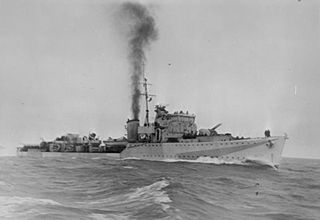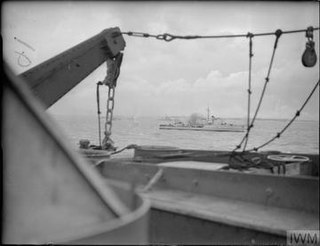
HMS Quorn was a Hunt-class destroyer of the Royal Navy, built in 1940 and sunk off the Normandy coast on 3 August 1944. The class were named after British fox and stag hunts, in this case, the Quorn Hunt, predominately based in Leicestershire.

ORP Krakowiak was a British Type II Hunt-class destroyer escort, used by the Polish Navy during World War II. Initially built for the Royal Navy, it bore the name of HMS Silverton during British use.

Adrias was a Type III Hunt-class destroyer that was originally built for the Royal Navy as HMS Border but never commissioned. Before her completion, she was loaned to the Royal Hellenic Navy on 20 July 1942 and commissioned as Adrias on 5 August 1942 in order to relieve heavy losses of ships sustained by the Royal Hellenic Navy during the German invasion of 1941 and throughout the war. Adrias took her name from the ancient Greek town of Adria in Italy, at the mouth of the Po river, after which the Adriatic Sea is named.

The River class was a class of fourteen destroyers of the Royal Canadian Navy (RCN) that served before and during the Second World War. They were named after Canadian rivers.

HMS Penylan was a Hunt-class destroyer of the Royal Navy. She was a member of the third subgroup of the class, and saw service in the Second World War, before being sunk by German E-boats in 1942.

HMS Eridge was a Hunt-class destroyer of the Royal Navy. She was launched in 1940 and served during the Second World War.

HMS Tetcott was a Type II British Hunt-class destroyer built for the Royal Navy during World War II. She was the only Royal Navy ship to be named after the Tetcott fox hunt.

HMS Tynedale was a Hunt-class destroyer of the first subgroup which served during the Second World War. She was sunk by the U-593 on 12 December 1943.

HMS Holcombe was a Type III Hunt-class destroyer of the Royal Navy. She was named after the Holcombe Hunt in Lancashire. She was the first and thus far only ship of the Royal Navy named HMS Holcombe.

HMS Wheatland was a Type 2 Hunt-class destroyer of the Royal Navy that served in the Second World War.

HMS Blankney was a Hunt-class destroyer of the Royal Navy and was the first and so far only warship to bear the Name. She was laid down on 17 May 1940 at John Brown & Company, Clydebank, Scotland, launched on 19 December 1940 and commissioned on 11 April 1941.

HMS Albrighton was a Type III Hunt-class destroyer built for the British Royal Navy. She entered service in February 1942, first carrying out an attack on German ships in the English Channel then taking part in the Dieppe Raid, rescuing survivors from the sinking destroyer HMS Broke. Albrighton was next assigned to search for and destroy the German auxiliary cruiser Komet, then escorted a convoy to Gibraltar in prevision of the Allied landings in North Africa. Between December 1942 and April 1943, she participated in the sinking of three more Axis ships with the First Destroyer Flotilla. During the Normandy Landings in June 1944, Albrighton served as a headquarters ship, then sank two German trawlers in the weeks after the invasion. After being converted to a destroyer in early 1945, she was damaged in a collision with a Landing Ship, then was assigned to the British Eastern Fleet. However, the war ended before she was deployed and Albrighton went into reserve.
HMS Southwold was a Type II British Hunt-class destroyer built for the Royal Navy during World War II. She served in the Mediterranean for a few months until she was sunk off Malta in March 1942.

HMS Brocklesby was a Type I Hunt-class destroyer of the Royal Navy. She served during the Second World War, spending much of the time in the English Channel and Mediterranean, taking part in the Dieppe Raid in 1942, and the Allied landings in Sicily and at Salerno in 1943. After the war, she was used as a sonar trials ship until 1963, and was sold for scrap in 1968.

HMS Berkeley was a Type I Hunt-class destroyer of the Royal Navy. She was a member of the first subgroup of the Hunt class and saw service in World War II before being bombed at Dieppe and then scuttled by HMS Albrighton.

HMS Cattistock (L35) was a Type I Hunt-class destroyer of the Royal Navy. She was a member of the first subgroup of the Hunt class and served throughout World War II before being scrapped in 1957.

HMS Airedale was a Hunt-class destroyer built for use by the British Royal Navy during the Second World War. She entered service in early 1942 as a convoy escort, being assigned to the Mediterranean Fleet in May. Airedale was sunk while escorting a convoy from Alexandria to Malta on 15 June 1942 by Sturzkampfgeschwader 3.

HMS Cottesmore was a Hunt-class destroyer of the British Royal Navy. The ship was built by the Scottish shipbuilder Yarrow at their Scotstoun, Glasgow shipyard in 1939–1940, being launched on 5 September 1940 and commissioning on 29 December that year.
HMS Limbourne (L57) was a Hunt-class escort destroyer, operated by the Royal Navy. She was sunk in action, off German-occupied Guernsey, on 23 October 1943.

HMS Puckeridge was a Hunt-class destroyer of the Royal Navy and first and so far only warship to bear the Name. The vessel was ordered on 4 September 1939 as part of the 1939 wartime emergency program. She was laid down on 1 January 1940 at the J. Samuel White yard, East Cowes, on the Isle of Wight, launched on 6 March 1941 and commissioned on 30 July 1941.


















